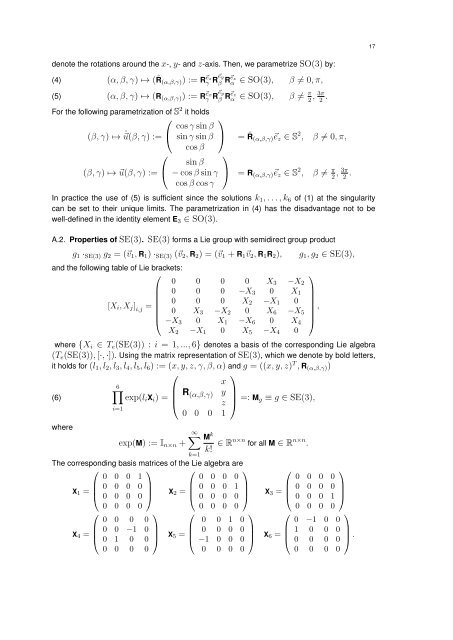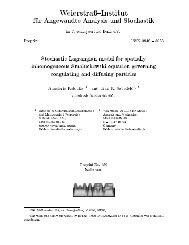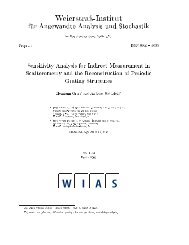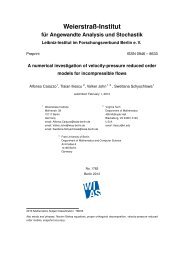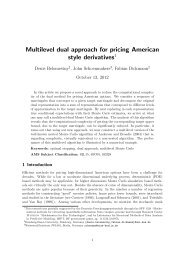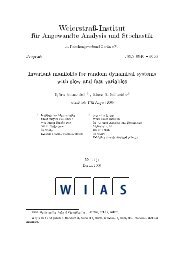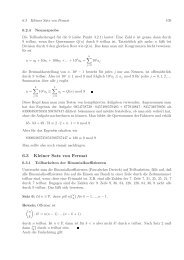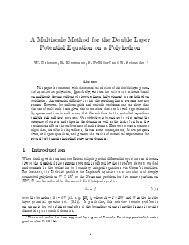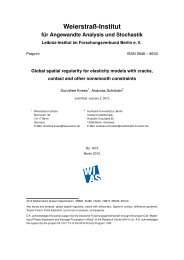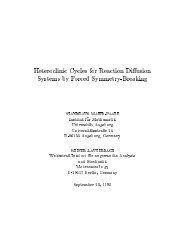PDF (5143 kByte) - WIAS
PDF (5143 kByte) - WIAS
PDF (5143 kByte) - WIAS
You also want an ePaper? Increase the reach of your titles
YUMPU automatically turns print PDFs into web optimized ePapers that Google loves.
denote the rotations around the x-, y- and z-axis. Then, we parametrize SO(3) by:<br />
(4)<br />
(5)<br />
(α, β, γ) ↦→ (ˆR(α,β,γ)) := R ez<br />
γ Rey<br />
β Rez<br />
α ∈ SO(3), β = 0, π,<br />
(α, β, γ) ↦→ (R(α,β,γ)) := R ex<br />
γ Rey<br />
β Rez α ∈ SO(3), β = π 3π , 2 2 .<br />
For the following parametrization of S2 it holds<br />
(β, γ) ↦→ ˆ ⎛<br />
⎞<br />
cos γ sin β<br />
u(β, γ) := ⎝ sin γ sin β ⎠<br />
cos β<br />
= ˆR(α,β,γ)ez ∈ S 2 ⎛<br />
⎞<br />
sin β<br />
(β, γ) ↦→ u(β, γ) := ⎝ − cos β sin γ<br />
cos β cos γ<br />
, β = 0, π,<br />
⎠ = R(α,β,γ)ez ∈ S 2 , β = π 3π , 2 2 .<br />
In practice the use of (5) is sufficient since the solutions k1, . . . , k6 of (1) at the singularity<br />
can be set to their unique limits. The parametrization in (4) has the disadvantage not to be<br />
well-defined in the identity element E3 ∈ SO(3).<br />
A.2. Properties of SE(3). SE(3) forms a Lie group with semidirect group product<br />
g1 ·SE(3) g2 = (v1, R1) ·SE(3) (v2, R2) = (v1 + R1v2, R1R2), g1, g2 ∈ SE(3),<br />
and the following table of Lie brackets:<br />
⎛<br />
0<br />
⎜ 0<br />
⎜<br />
[Xi, Xj] i,j = ⎜ 0<br />
⎜ 0<br />
⎝ −X3<br />
0<br />
0<br />
0<br />
X3<br />
0<br />
0<br />
0<br />
0<br />
−X2<br />
X1<br />
0<br />
−X3<br />
X2<br />
0<br />
−X6<br />
X3<br />
0<br />
−X1<br />
X6<br />
0<br />
−X2<br />
X1<br />
0<br />
−X5<br />
X4<br />
⎞<br />
⎟ ,<br />
⎟<br />
⎠<br />
X2 −X1 0 X5 −X4 0<br />
where {Xi ∈ Te(SE(3)) : i = 1, ..., 6} denotes a basis of the corresponding Lie algebra<br />
(Te(SE(3)), [·, ·]). Using the matrix representation of SE(3), which we denote by bold letters,<br />
it holds for (l1, l2, l3, l4, l5, l6) := (x, y, z, γ, β, α) and g = ((x, y, z) T , R(α,β,γ))<br />
(6)<br />
where<br />
i=1<br />
⎛<br />
6<br />
⎜<br />
exp(liXi) = ⎜<br />
⎝ R (α,β,γ)<br />
exp(M) := In×n +<br />
x<br />
y<br />
z<br />
0 0 0 1<br />
∞<br />
k=1<br />
⎞<br />
⎟<br />
⎠ =: Mg ≡ g ∈ SE(3),<br />
M k<br />
k! ∈ Rn×n for all M ∈ R n×n .<br />
The corresponding basis matrices of the Lie algebra are<br />
⎛<br />
⎞ ⎛<br />
⎞<br />
0 0 0 1<br />
0 0 0 0<br />
⎜<br />
X1 = ⎜ 0 0 0 0 ⎟ ⎜<br />
⎟ X2 ⎝ 0 0 0 0 ⎠ = ⎜ 0 0 0 1 ⎟<br />
⎝ 0 0 0 0 ⎠<br />
⎛<br />
0<br />
⎜<br />
X3 = ⎜ 0<br />
⎝ 0<br />
0<br />
0<br />
0<br />
0<br />
0<br />
0<br />
⎞<br />
0<br />
0 ⎟<br />
1 ⎠<br />
0<br />
⎛<br />
0<br />
⎜<br />
X4 = ⎜ 0<br />
⎝ 0<br />
0<br />
0<br />
0<br />
1<br />
0 0<br />
⎞<br />
0 0<br />
−1 0 ⎟<br />
0 0 ⎠<br />
0 0 0 0<br />
0 0 0 0<br />
0 0 0 0<br />
X5<br />
⎛<br />
⎞<br />
0 0 1 0<br />
⎜<br />
= ⎜ 0 0 0 0 ⎟<br />
⎝ −1 0 0 0 ⎠<br />
0 0 0 0<br />
X6<br />
⎛<br />
0<br />
⎜<br />
= ⎜ 1<br />
⎝ 0<br />
⎞<br />
−1 0 0<br />
0 0 0 ⎟<br />
0 0 0 ⎠<br />
0 0 0 0<br />
.<br />
17


